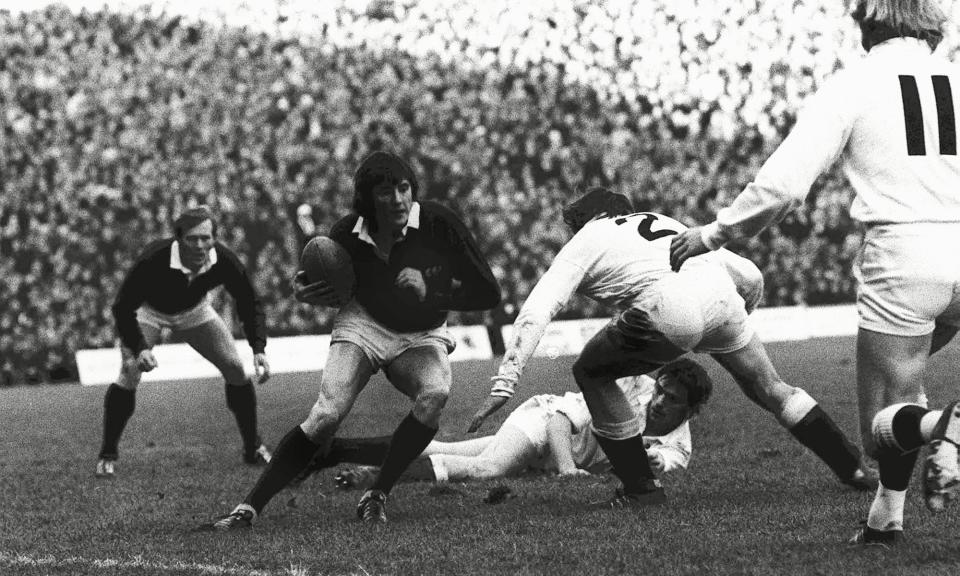Rugby’s rulers ignore the game’s marvellous heritage at their peril

Some of us went back in time at the weekend. There was no Doctor Who-style Tardis involved, just an easyJet flight (beware their petty hand luggage regulations) to Scotland for a reunion of old student friends. It was good fun and, certain hairlines aside, reassuring to find out how little people had changed in the 40-odd years since we first encountered each other in the stylish salons – OK, the saloon bars and Spud-U-Like shops – of Edinburgh in the 1980s.
And because it was a lovely afternoon on Saturday and we fancied reminding ourselves of our former athletic selves, a few of us decided to wander up the road and take in a game of club rugby. Heriot’s v Watsonians playing in – checks notes – the FOSROC Super Series Sprint. Sitting behind the posts at Goldenacre, with the sun shining and Edinburgh’s ancient skyline shimmering in the distance, the evocative old venue really did seem appropriately named. We all enjoyed the day immensely.
Related: Reed doubles up on 100th appearance as Sale stun Harlequins in 10-try thriller
As it happened, the Scotland head coach Gregor Townsend was also there, watching his 22-year-old son Christian playing at full-back for Heriot’s. And when we piled into the clubroom for a mutton pie – £2, don’t examine the filling too closely – it was impossible to miss the large number of framed photographs of ex-Scotland internationalists hanging on the wall. You know you’re getting older when faces of a vaguely similar vintage are now dripping in sepia.
By sheer coincidence, one of our number found himself staring up at a picture of his own grandfather. Back in the day Dan Drysdale was one of the foremost full-backs of his era, a stand-out player both for Scotland and the British & Irish Lions. The late Clem Thomas, in his History of the British Lions, described Drysdale as having “played marvellously throughout as a running full-back” during the 1924 tour to South Africa. The following year, in 1925, he was a similarly key member of the first Scotland side in history to secure a grand slam.
Almost exactly a century later, it felt a timely moment to pay our respects to the fabled legend. Just as it did, a little further along the row of pictures, to touch the (vanished) forelock in tribute to another brilliant local full-back. Even in faraway rural England, some of us saw Andy Irvine as a supreme sporting hero, his constant can-do enthusiasm for counter-attacking among the global game’s most glorious sights. It reached the point where my adolescent mind started to wonder if “Heriot’s FP” stood for “Fabulous Players” rather than “Former Pupils”.
Remarkably, another celebrated attacking Test full-back, Ken Scotland, was educated at the same establishment, making the lineage even more impressive. People used to talk about whistling down the mines of northern England for fast bowlers or monitoring the production line at Max Boyce’s Welsh fly-half factory. If there is a Scottish equivalent for full-backs, it can be found a well-struck punt away from Edinburgh’s Royal Botanic Garden.
Which begged a slightly broader question. If the Heriot’s No 15 jersey rates among the most mythical of British and Irish club jerseys, which other garments merit potential inclusion in the ultimate kitbag? The blue and black No 9 of Cardiff should certainly be in the frame, with Gareth Edwards and Terry Holmes just two of the distinguished alumni to have worn it. How about the red Munster No 10 jersey, worn so memorably by, among others, Tony Ward and Ronan O’Gara? Or the blue Leinster No 13 shirt, forever synonymous with Brian O’Driscoll?
There are plenty more contenders, clearly, just as there are endless old stadiums inhabited by the ghosts of rugby’s past. If you are passing Redruth, for example, go and pay homage to “Hellfire Corner” and imagine the ominous studs of ferocious Cornish packs of yesteryear clattering towards you. Or, alternatively, stand for a while in the Shed at Kingsholm and visualise those cold, dark evenings when Cherry & White forwards would eat innocent Oxbridge half-backs for tea, howled on by home supporters who, in many cases, viewed a trip to Cheltenham as an exotic awayday.
In short, we are talking about heritage. Rugby has loads of it and, right now, it is not terribly in fashion. The professional game has morphed into something very different – vastly improved in numerous respects, less fabulous in others – and anonymous-looking new stadia have largely replaced the old school cathedrals.
Which is fine, up to a point. Any game that stands still will stagnate; a sport that lives in the past is inevitably doomed. But when, the other week, the hugely promising England forward, Chandler Cunningham-South, confessed to having no idea his mentor Richard Hill had been a World Cup winning flanker in 2003 it further served to underline how quickly rugby’s once-central pillars can fade into the background.
The aforementioned FOSROC Super Series, introduced as recently as 2019, is the latest casualty, set to be scrapped this year in the ceaseless pursuit of change. Exactly how the Scottish domestic scene will look in future remains unclear but mutton pies, old school full-backs and simple pleasures are not obviously part of the zeitgeist. If it is smart, though, the game will realise rugby’s appeal is not just about the shiny and the new. It is also built on tradition, fellowship and an enduring truth: the best sporting memories are not always created on the biggest of stages or the most high-profile of days.
This is an extract taken from our weekly rugby union email, the Breakdown. To sign up, just visit this page and follow the instructions.

